BigCommerce vs Shopify Top 10 Key Differences Explained
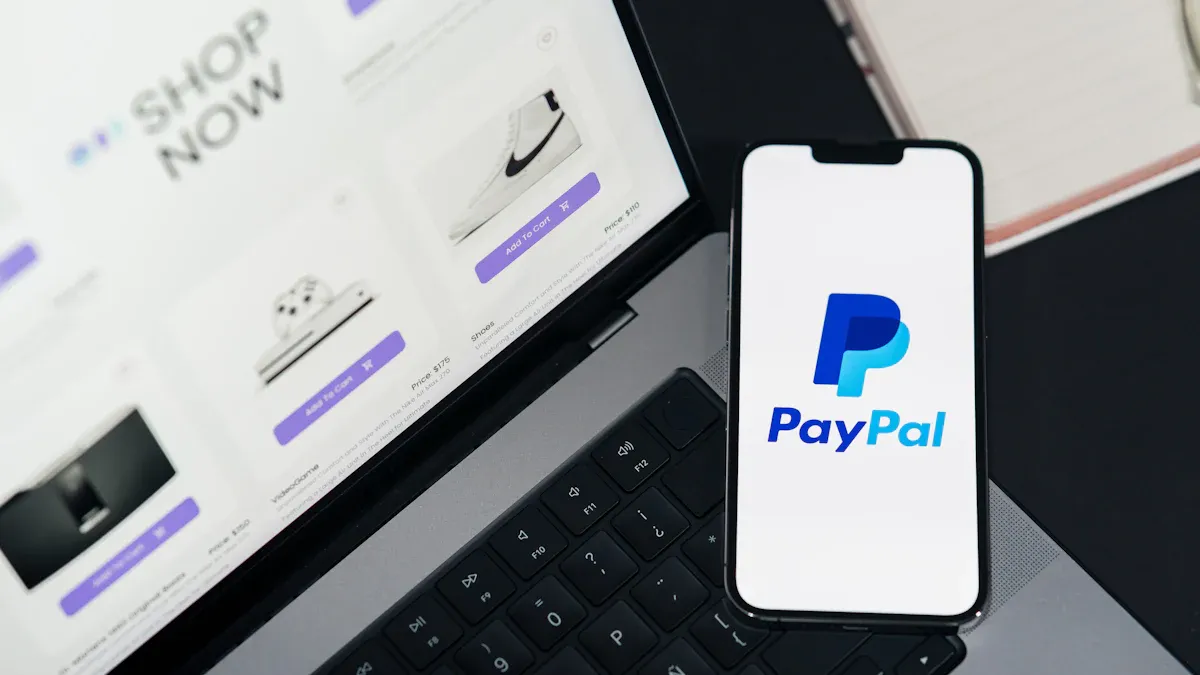
Choosing between bigcommerce vs. shopify can feel overwhelming. You want your ecommerce store to grow fast, but which platform really fits your needs? Let’s start with some quick facts. Shopify powers over 2.8 million US websites, holding a 28.41% market share in the US ecommerce space. Take a look at this chart showing Shopify’s reach across the industry:
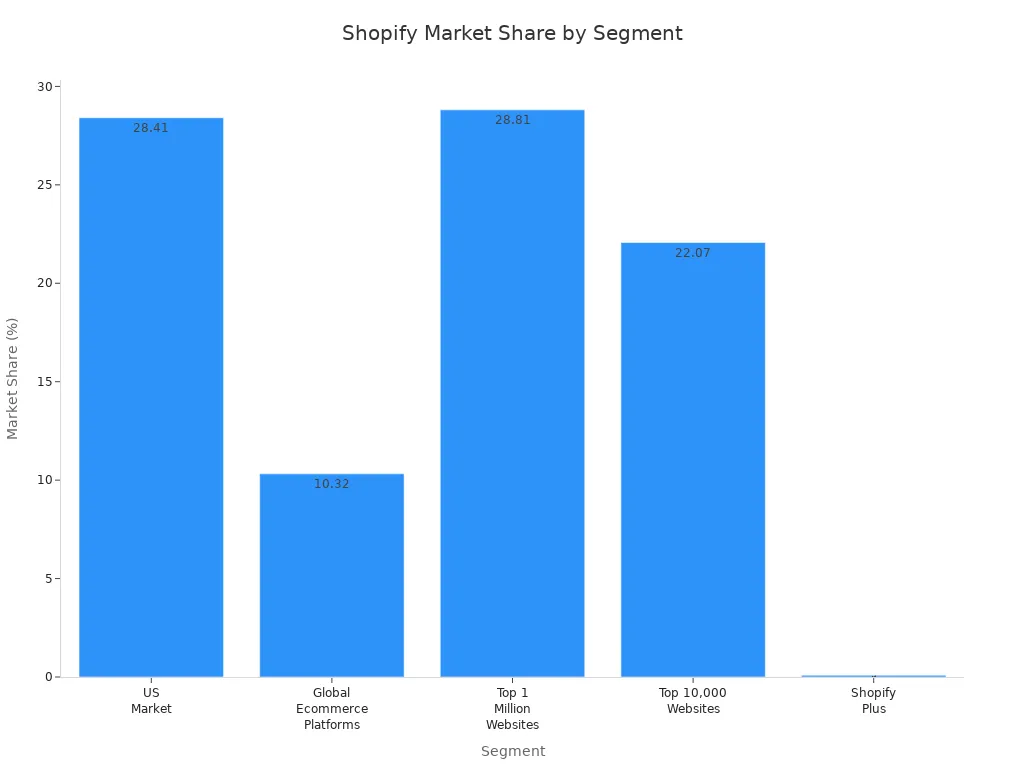
When you compare bigcommerce vs. shopify, both score high in user satisfaction, with Shopify at 8.3/10 and BigCommerce at 7.9/10. See the table below for a quick look:
| Platform | Overall Score (out of 10) | Customer Satisfaction (Stars out of 5) |
|---|---|---|
| Shopify | 8.3 | 3.8 |
| BigCommerce | 7.9 | 3.8 |
You might wonder if Shopify is better than BigCommerce, or vice versa. The answer depends on your business goals. Some stores need advanced apps, others need easy design tools. Many ecommerce owners now use Sobot and Sobot AI to connect with shoppers across channels, making support and sales seamless and boosting customer engagement.
Let’s dive in and see which platform—bigcommerce vs. shopify—gives you the best shot at ecommerce success.
Pricing Comparison

Plans
When you look at shopify vs bigcommerce, both offer clear pricing plans for ecommerce businesses. You get four main options on each platform, with discounts if you pay yearly. Here’s a quick table to help you compare:
| Plan Level | BigCommerce Monthly Price | BigCommerce Annual Price (25% off) | Shopify Monthly Price | Shopify Annual Price (25% off) | Notes |
|---|---|---|---|---|---|
| Entry Level | $39 (Standard) | $29 | $39 (Basic Shopify) | $29 | Shopify has a $5 Starter plan not offered by BigCommerce |
| Mid Tier | $105 (Plus) | $79 | $105 (Shopify) | $79 | Both have similar mid-tier pricing |
| High Tier | $399 (Pro) | $299 | $399 (Advanced Shopify) | $299 | Comparable pricing at high tier |
| Enterprise Level | Custom pricing | Custom pricing | Starts at $2300 (Shopify Plus) | Starts at $2300 | Enterprise plans are custom priced |
Tip: Both shopify vs bigcommerce give you a 25% discount if you choose annual billing.
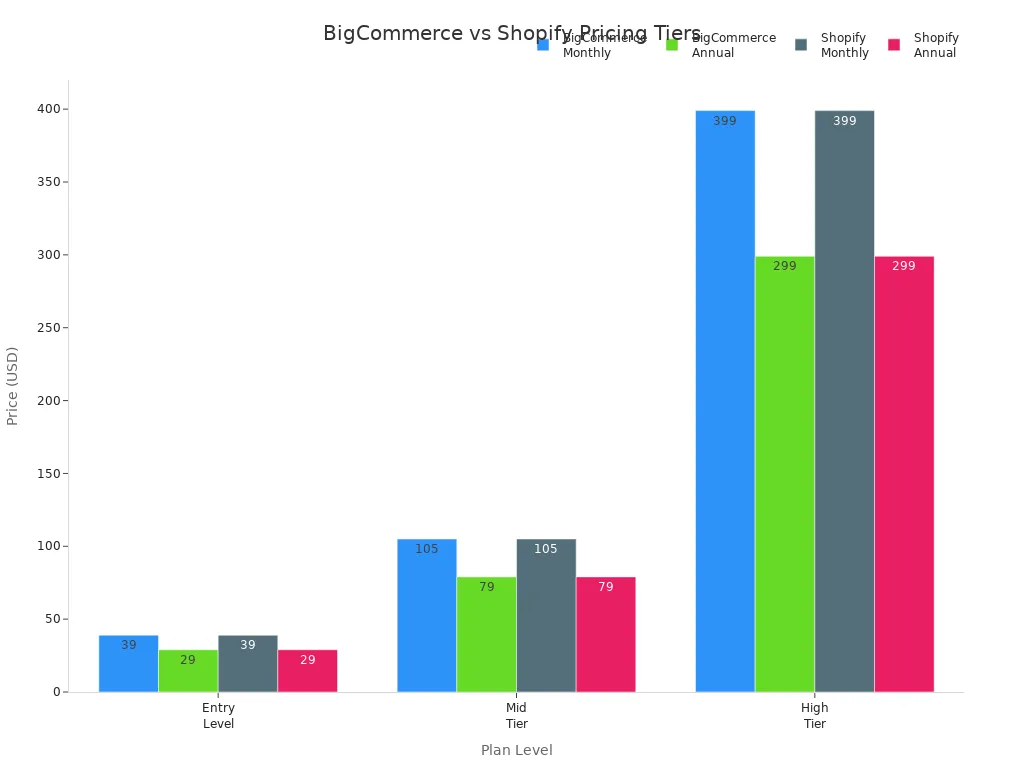
Fees
Fees can make a big difference in the bigcommerce vs shopify debate. Shopify charges up to 2% in transaction fees if you don’t use Shopify Payments. Bigcommerce does not charge any transaction fees, no matter which payment gateway you pick. This can save you a lot, especially as your ecommerce store grows. Bigcommerce pricing also gives you unlimited staff accounts, while Shopify limits staff based on your plan. Shopify includes abandoned cart recovery on all plans, but Bigcommerce only adds this feature from the Plus plan up. Bigcommerce plans have sales volume limits, so you may need to upgrade as your sales increase. Shopify does not have sales limits.
Value
When you compare shopify vs bigcommerce on value, you need to look at what you get for your money. Both platforms offer strong ecommerce features, but they bundle them differently. Shopify often requires paid apps for things like extra product options or custom pricing per country. Bigcommerce includes some features, like persistent carts and abandoned cart emails, in higher pricing plans. Bigcommerce pricing can be more predictable for steady sales, while Shopify may seem cheaper at first but can add up with extra fees and apps. If you want to connect with customers across channels, both platforms work well with tools like Sobot Live Chat. Sobot helps you unify support and sales, making your ecommerce business more efficient and customer-friendly. You can learn more about Sobot’s ecommerce solutions here.
Ease of Use
Setup
When you start your ecommerce journey, setup is the first big step. Shopify makes this process super simple. You get a step-by-step onboarding guide, clear language, and even video tutorials. Most users can launch a basic store in less than two days. Bigcommerce gives you a detailed setup guide too, but it feels more technical. You see more jargon and extra steps. If you want advanced features, bigcommerce lets you add them right away, but this can slow you down if you’re new to ecommerce.
Here’s a quick look at how setup compares:
| Factor | Shopify | BigCommerce |
|---|---|---|
| Interface | Extremely user-friendly | Moderately intuitive |
| Onboarding Help | Videos, checklists, clear steps | Good knowledge base, less guided |
| Setup Speed | Fast, 19-54 hours | Slower, more steps |
Tip: If you want to connect live chat or support tools like Sobot, both platforms let you do this during setup.
Dashboard
You’ll spend a lot of time in your dashboard, so it needs to be easy to use. Shopify’s dashboard is clean and simple. You see what you need right away—products, orders, and reports. Navigation is smooth, and you don’t get lost. Bigcommerce offers a sidebar menu with lots of options. You get powerful tools for bulk editing and inventory, but the dashboard can feel overwhelming at first. Both platforms give you 24/7 support and help centers right from the dashboard, so you’re never stuck.
| Aspect | Shopify | BigCommerce |
|---|---|---|
| Layout | Minimal, straightforward | Sidebar, many options |
| Product Management | Simple, smooth flow | More options, bulk editing |
| Support Access | 24/7, help center, forums | 24/7, help icon, knowledge base |
Learning Curve
Shopify ease of use stands out for beginners. You don’t need to know code or have technical skills. The platform guides you, and you can find answers fast. Bigcommerce ease of use is better for users who want more control and don’t mind learning new tools. The learning curve is steeper, but you get more flexibility. If you want to grow your ecommerce business and use advanced features, bigcommerce gives you that power. Shopify is perfect if you want to get started quickly and focus on selling.
Note: Many ecommerce owners use Sobot’s unified workspace to manage customer chats and support, making both platforms even easier to handle as your store grows.
Themes & Design

Templates
When you build your ecommerce store, the look and feel matter a lot. Both bigcommerce and shopify give you a wide range of themes to choose from. You want your site to stand out, so picking the right template is key. Let’s compare what you get:
| Platform | Free Themes | Paid Themes | Price Range (Paid) | Design Quality and Customization Insights |
|---|---|---|---|---|
| Shopify | ~12 | 144 | $170 - $380 | Unique, beginner-friendly, drag-and-drop editor, easy theme switching |
| BigCommerce | 15 | ~229 | $150 - $400 | Modern, responsive, similar to each other, best for users with HTML/CSS skills |
You can see that shopify offers about 12 free themes and 144 paid ones. Bigcommerce gives you 15 free themes and around 229 paid themes. Paid shopify themes cost between $170 and $380, while bigcommerce themes range from $150 to $400. Most shopify themes are unique and easy to use, even if you’re new to ecommerce. Bigcommerce themes look modern and work well on phones, but many look alike. If you want more control, bigcommerce themes let you dive into the code.
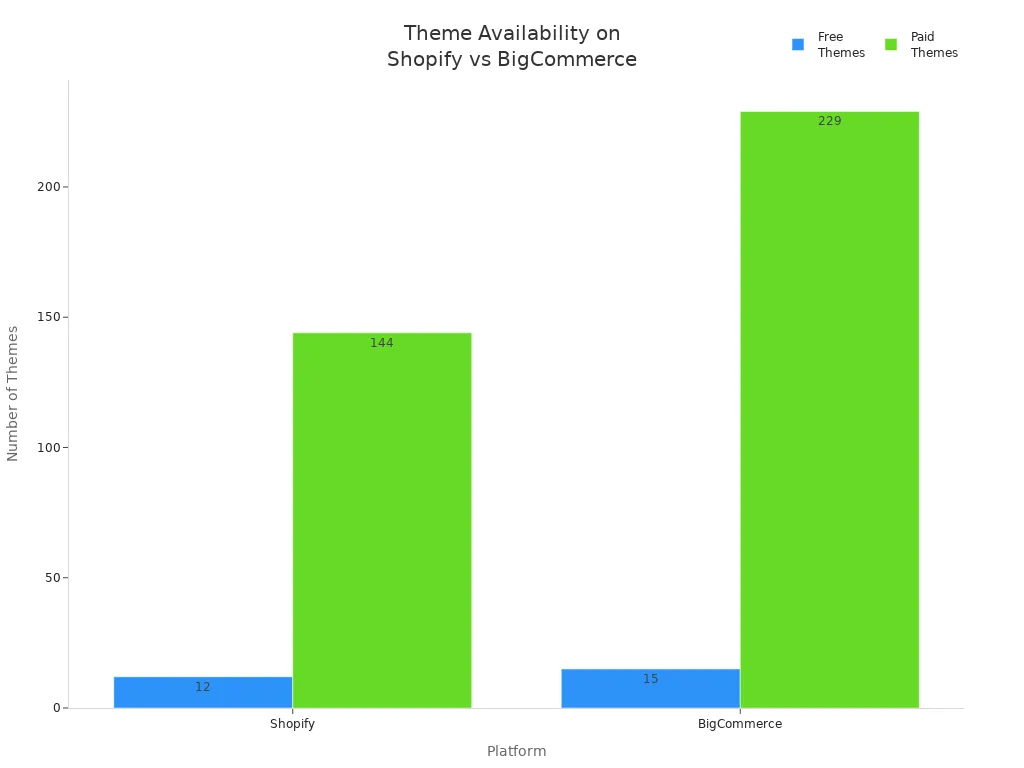
Tip: Both platforms let you preview themes before you buy, so you can see how your product presentation and features will look.
Customization
You want your store to match your brand. Customization is where shopify and bigcommerce really show their differences. Shopify themes come with a drag-and-drop editor. You can change colors, fonts, and layouts without touching any code. This makes shopify themes perfect for beginners who want to focus on product presentation and features.
Bigcommerce themes offer more advanced features for users who know HTML or CSS. You get a lot of design options, but you might need some technical skills. The admin area is easy to use, but editing bigcommerce themes can take more time to learn. If you manage a large store, bigcommerce lets you handle multiple storefronts smoothly.
| Feature/Aspect | Shopify | BigCommerce |
|---|---|---|
| Theme Customization | User-friendly, easy for beginners | Advanced, best for technical users |
| Usability | Simple, fast edits | More learning needed, but powerful |
| Bulk Editing Limitations | No major limits | Editor limited to 100 SKUs at once |
| Multi-storefront Management | Yes | Yes, more seamless |
Both platforms support no-code design tools, but shopify themes make it easier to switch looks without rebuilding your site. Bigcommerce themes shine if you want deep control over your store’s features. If you want to boost your store’s design and customer engagement, you can add tools like Sobot Live Chat. Sobot helps you keep all your customer chats in one place, making your ecommerce site even more user-friendly.
Apps & Addons
App Stores
When you want to add new features to your store, you look at the app stores for bigcommerce and shopify. Both platforms give you a way to boost your store with extra tools. The shopify app store stands out because it offers over 8,000 apps. You can find apps for marketing, shipping, reviews, and more. This huge selection means you can add almost any feature you want. Bigcommerce also has an app store, but you will not find a clear number of available apps. Still, you get a solid range of features for payments, shipping, and product management. Many store owners use these apps to make their stores work better and save time.
Here is a quick comparison:
| Platform | Number of Apps | Types of Features Available |
|---|---|---|
| Shopify | 8,000+ | Marketing, sales, support, shipping |
| BigCommerce | Not specified | Payments, shipping, product tools |
Tip: Always check reviews before you add new features to your bigcommerce or shopify store. Some apps work better with certain themes or business types.
Integration
You want your store to work with other tools. Both bigcommerce and shopify make integration easy. You can connect your store to email services, social media, and even live chat. Many business owners choose Sobot Live Chat to talk with customers in real time. Sobot works with both bigcommerce and shopify, letting you manage chats from your website, WhatsApp, Facebook, and more. This helps you keep all your customer messages in one place. You can also use Sobot’s features like AI-powered chat and analytics to boost your support. Bigcommerce and shopify both support many features for integration, so you can build the perfect setup for your business.
Some popular integration features include:
- Connecting to payment gateways
- Linking with shipping providers
- Adding marketing tools
- Using customer support features like Sobot Live Chat
You get more control and better customer service when you use these features. Bigcommerce and shopify both give you the power to grow your store with the right addons.
Payment Options
Gateways
When you run an online store, you want your customers to pay easily. Both bigcommerce and shopify give you a wide range of payment gateways. Bigcommerce supports over 65 pre-integrated payment gateways. You can accept payments in 230 countries and use more than 140 currencies. Shopify also offers many payment gateways, but it pushes you to use Shopify Payments, its own payment system. You can still use third-party payment gateways like PayPal, Apple Pay, and Authorize.net on both platforms.
Here’s a quick comparison:
| Feature | BigCommerce | Shopify |
|---|---|---|
| Number of Payment Providers | Over 65 pre-integrated providers | Shopify Payments plus third-party gateways |
| Geographic Coverage | 230 countries, 140+ currencies | Multi-currency support, international focus |
| Supported Payment Methods | PayPal, Apple Pay, local payment methods | Shop Pay, Apple Pay, Google Pay, PayPal, local methods |
| Exclusive Partnerships | None | None |
| Mobile Optimization | Yes | Yes |
You can connect PayPal Express, Apple Pay, and even local payment methods on both bigcommerce and shopify. Both platforms make it easy to set up payment gateways. You just follow the integration guides. If you want to offer financing options or digital wallets, both platforms support those too. Sobot Live Chat works smoothly with both bigcommerce and shopify, so you can help customers with payment questions right from your chat window.
Tip: Bigcommerce does not have exclusive partnerships, so you get more freedom to choose the payment gateways that fit your business.
Fees
Payment fees can eat into your profits, so you need to know what you’ll pay. Bigcommerce stands out because it does not charge extra transaction fees, no matter which payment gateways you use. You only pay the fees set by the payment provider, like PayPal or Stripe. Shopify charges extra fees if you do not use Shopify Payments. These fees range from 2% on the Basic plan to 0.5% on the Advanced plan. If you use Shopify Payments, you pay only the standard processing fee.
Here’s a breakdown:
| Platform | Plan | Online Transaction Fee (Shopify Payments) | Extra Fee for Third-Party Gateways | Notes |
|---|---|---|---|---|
| Shopify | Basic | 2.9% + $0.30 | 2% | Extra fee if not using Shopify Payments |
| Shopify | Shopify | 2.6% + $0.30 | 1% | Extra fee if not using Shopify Payments |
| Shopify | Advanced | 2.4% + $0.30 | 0.5% | Extra fee if not using Shopify Payments |
| BigCommerce | All Plans | Varies by payment provider | None | No extra transaction fees |
Bigcommerce lets you keep more of your money, especially if you want to use different payment gateways. Shopify’s extra fees can add up if you use third-party payment gateways. Both platforms are PCI compliant and mobile optimized, so your customers can pay safely from any device.
If you want to track payment trends or help customers with payment issues, Sobot’s unified workspace makes it easy. You can see all your payment chats and support tickets in one place, no matter which payment gateways you use.
Omnichannel Support
Channels
When you run an online store, you want to reach your customers everywhere. Both bigcommerce and shopify make this possible with strong omnichannel support. Bigcommerce lets you connect your store to channels like Google, Facebook, Instagram, eBay, Wish, and Mercado Libre. You can manage your inventory, pricing, and customer data from one place. This means you never lose track of your products or your customers, no matter where you sell.
Shopify also gives you powerful omnichannel support. You can sell on social media, marketplaces, and even in person with Shopify POS. Shopify Plus takes it further with real-time inventory updates and AI tools for personalizing the shopping experience. You get flexible payment and shipping options, so your customers always have choices. Both bigcommerce and shopify offer integrations with backend systems like ERP and CRM, making your business run smoothly.
Here’s a quick table to compare their omnichannel support features:
| Platform | Omnichannel Support Highlights |
|---|---|
| BigCommerce | Direct integration with Google, Facebook, Instagram, eBay, Wish, Mercado Libre. Centralized control of inventory and customer data. Strong API for custom integrations. |
| Shopify | Real-time inventory updates, AI personalization, POS, social media, and marketplace selling. Extensive app integrations. |
Tip: If you want to grow fast, using omnichannel support on bigcommerce or shopify helps you reach more customers and boost sales.
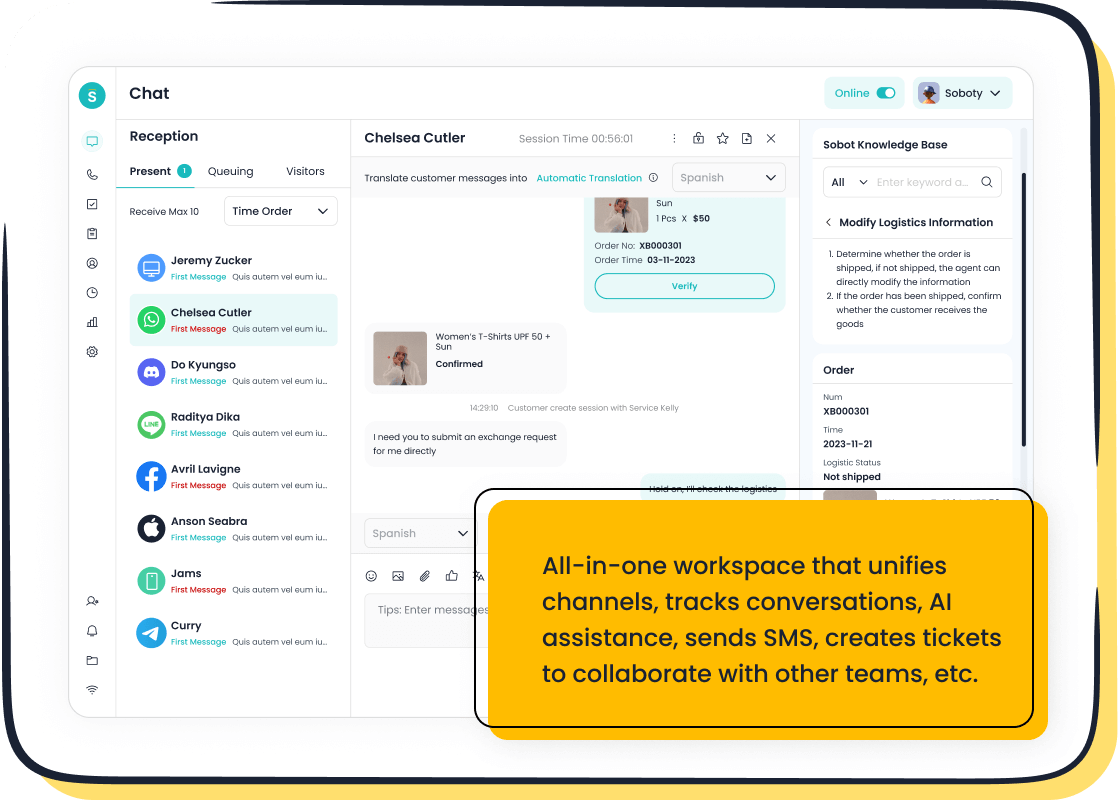
Sobot Live Chat
You want to give your customers fast, friendly support on every channel. That’s where Sobot Live Chat comes in. Sobot connects with bigcommerce and shopify, letting you chat with customers on your website, WhatsApp, Facebook, Instagram, Telegram, and Discord—all from one workspace. You never miss a message, and your team can answer questions right away.
Sobot Live Chat uses AI to help your agents work smarter. You can see all your customer chats, tickets, and data in one place. This makes support easy and keeps your customers happy. Sobot even gives you analytics, so you know how well your support is working. Many bigcommerce and shopify stores use Sobot to boost conversion rates by 38% and improve customer loyalty.
If you want to unify your support and sales, Sobot is a smart choice. You can try Sobot Live Chat for free and see how it fits your bigcommerce or shopify store. Learn more about Sobot’s ecommerce solutions here.
Sales Tools
Features
When you run an ecommerce dropshipping store, you want sales tools that make your life easier. Both bigcommerce and shopify give you a strong set of features to help you manage your business. Let’s look at how these features stack up:
| Sales Tool Category | BigCommerce Features | Shopify Features | Impact on Store Performance |
|---|---|---|---|
| Inventory Management | Native inventory tracking, low-stock alerts, bulk editing | Inventory tracking, alerts, bulk editing | Prevents stockouts and keeps your ecommerce dropshipping store running smoothly |
| Order Processing | Integrated payment gateways, subscription management, multi-channel selling | Shopify Payments, subscription management, multi-channel selling | Smooth order handling means fewer abandoned carts and happier customers |
| Marketing Tools | Abandoned cart recovery, banners, social media selling, SEO features | Abandoned cart recovery, pop-ups, social selling, built-in blogging, email marketing | Boosts engagement, recovers lost sales, and improves your store’s reach |
| Email Marketing | Integrates with top email platforms | Built-in email marketing, sync with popular services | Helps you send targeted campaigns and connect with your audience |
| Analytics & Reporting | Real-time analytics, customer segmentation, inventory tracking | Dashboards, advanced reporting on higher plans | Lets you make smart decisions and grow your ecommerce dropshipping business |
| Performance & Scalability | Fast page loads, reliable servers, scalable plans | Fast page loads, reliable servers, scalable plans | Keeps your store fast and ready for growth |
Bigcommerce gives you deep native features like advanced catalog management and a built-in review system. Shopify relies more on apps for advanced features, but you still get a lot out of the box. If you want to boost sales, both platforms support dropshipping apps and tools. Sobot Live Chat can help you engage shoppers in real time, answer questions, and increase conversions. You can track chats and sales data together, making your support team more effective.
Tip: Use analytics features to spot trends and adjust your marketing for better results.
B2B
If you sell to other businesses, you need special features for B2B ecommerce dropshipping. Bigcommerce stands out with its native B2B features. You get quotes, account hierarchies, invoicing, and multi-storefront management right from the start. Shopify Plus offers some B2B features, but you often need third-party apps to match what bigcommerce gives you out of the box.
Here’s a quick comparison:
| Feature | BigCommerce B2B Edition | Shopify Plus |
|---|---|---|
| Native B2B Functionality | Quotes, account hierarchies, invoicing, multi-storefront, sales rep tools | Limited native features, relies on apps |
| Multi-Storefront Management | Yes | No |
| Customization & Flexibility | Open API, buyer portals, custom workflows | Limited customization |
| Payment Options | ACH, purchase orders, credit limits, no extra transaction fees | Fewer B2B payment methods, extra fees |
| Shared Shopping Lists | Yes | No |
| Sales Rep Tools | Yes | No |
| Account Hierarchies | Yes | No |
| Quote & Invoice Management | Built-in RFQ and invoice portal | Needs apps |
| API & Integration | Open APIs for ERP, CRM, custom integrations | Limited API calls |
| Total Cost of Ownership | Lower due to built-in features | Higher due to app reliance |
Many companies have switched from shopify to bigcommerce for B2B because of these features. Bigcommerce’s open architecture lets you connect with ERP and CRM systems easily. This flexibility helps you scale your ecommerce dropshipping business without extra costs. Shopify’s closed system can make advanced B2B setups harder and more expensive.
If you want to support B2B customers across channels, Sobot’s omnichannel solutions help you manage chats, orders, and support in one place. This unified approach boosts efficiency and customer satisfaction.
Marketing & SEO
SEO
If you want your store to show up on Google, you need strong seo. Both bigcommerce and shopify give you tools to help your site rank higher. Bigcommerce lets you edit page titles, meta descriptions, and URLs. You can add alt text to images and use built-in seo features like automatic sitemaps. Shopify also gives you control over titles, descriptions, and URLs. You can edit robots.txt files and add redirects. Both platforms support mobile-friendly designs, which is important for seo.
Bigcommerce stands out with more advanced seo features. You get full control over your URLs, which helps you avoid duplicate content. Shopify sometimes adds extra words to URLs, which can hurt seo. Bigcommerce also lets you use schema markup for rich snippets. This makes your products look better in search results. Shopify has some seo features, but you may need apps for advanced options.
Here’s a quick table to compare seo features:
| Platform | Custom URLs | Meta Tags | Schema Markup | Mobile Friendly | SEO Apps |
|---|---|---|---|---|---|
| BigCommerce | Yes | Yes | Yes | Yes | Yes |
| Shopify | Limited | Yes | Limited | Yes | Yes |
Tip: Use Sobot Live Chat to answer customer questions fast. Quick responses can lead to better reviews, which help your seo.
Email marketing helps you bring shoppers back. Shopify gives you a built-in tool called Shopify Email. You can send up to 10,000 free emails each month. You get automation features like abandoned cart emails and winback campaigns. You can manage your store and email marketing in one place. This saves you time and money. Some users say the templates are basic and the filters can be confusing, but the tool is easy to use.
Bigcommerce does not have built-in email marketing tools. You need to use third-party apps. This can make things more complex and add extra costs. Many users see this as a downside compared to shopify. If you want to connect with shoppers across channels, Sobot’s omnichannel solutions help you send messages on WhatsApp, SMS, and more. This keeps your marketing simple and effective.
Note: Shopify’s email marketing is best if you want convenience. Bigcommerce gives you more freedom to pick your favorite tools, but you need to set them up yourself.
Security & Reliability
When you run an online store, you want to know your business is safe. Security and reliability matter for every store owner. Both bigcommerce and shopify take security seriously, but they do things a little differently.
Compliance
You need your store to meet the highest security standards. Bigcommerce and shopify both make this easy. Bigcommerce meets PCI DSS Level 1, which is the top level for payment security. You also get GDPR and CCPA compliance, so your customers’ data stays private. Bigcommerce uses AES-256 encryption for data and SSL/TLS protocols for secure exchanges. You get firewalls, intrusion detection, and continuous monitoring. Here’s a quick look at bigcommerce security features:
| Security Certification / Compliance Standard | BigCommerce Details |
|---|---|
| PCI DSS Level 1 | Compliant (highest tier of payment security) |
| GDPR | Compliant (data privacy regulation) |
| CCPA | Compliant (data privacy regulation) |
| Encryption | AES-256 encryption for data transmissions |
| Secure Protocols | SSL/TLS protocols for secure data exchange |
| Security Measures | Firewalls, intrusion detection systems, continuous monitoring |
| Additional Security Features | Multi-layered security, encrypted SSL certificates at checkout |
Shopify also keeps your store secure. Shopify is a hosted SaaS platform, so PCI compliance comes built in. You do not have to worry about most security steps. Shopify handles the hard parts, but you still need to fill out some forms if you process a lot of payments. This shared responsibility model means shopify gives you a secure environment, and you just follow a few simple steps.
Tip: Sobot helps you keep customer chats and data secure by using encrypted channels and secure integrations with both bigcommerce and shopify.
Uptime
You want your store to stay open all the time. Bigcommerce and shopify both focus on reliability. Shopify has an uptime of 99.98% over the past year. This means your shop stays online almost all the time. Shopify uses a global CDN and automatic server scaling, so your store loads fast and stays secure.
Bigcommerce shines during busy times. In Cyber Week 2024, bigcommerce had 100% uptime for the 11th year in a row. This shows bigcommerce can handle high traffic and keep your store running. While there is no full-year uptime number for bigcommerce, you can trust its security and reliability during peak sales.
If you want to boost your store’s security and reliability, Sobot’s solutions work with both platforms. Sobot keeps your customer data safe and helps you manage support without worry.
Customer Support
Support Channels
When you run an online store, you want fast and reliable customer support. Both bigcommerce and shopify offer many ways to get help. You can reach out by live chat, email, or phone. Shopify gives you 24/7 live chat and phone support on all plans. Bigcommerce only offers 24/7 live chat on Enterprise plans. If you use a lower bigcommerce plan, you might wait longer for help. Shopify usually answers in under five minutes, while bigcommerce can take six to twenty-four hours on lower tiers.
Here’s a quick look at how their customer support compares:
| Support Channel / Feature | Shopify | BigCommerce |
|---|---|---|
| Live Chat | 24/7 live chat on all pricing plans | 24/7 live chat limited to Enterprise plans |
| Email Support | Available on all plans | Available on all plans |
| Phone Support | 24/7 on all plans | Expanded hours on Plus plans; limited on lower tiers |
| Dedicated Account Managers | For larger accounts | For Enterprise plans |
| Average Response Time (Peak) | Sub-5 minutes | 6-24 hours on lower tiers |
| Self-Help Resources | Knowledge base, tutorials, webinars | Knowledge base, tutorials, webinars |
You get a lot of self-help resources with both bigcommerce and shopify. Shopify has Ecommerce University and live training. Bigcommerce offers partner-created content for apps. If you want fast answers, shopify usually wins for speed and access.
Tip: Always check your plan details. Some bigcommerce support features only unlock on higher tiers.
Sobot Integration
You want your customer support to stand out. Sobot makes this easy. Sobot Live Chat connects with both bigcommerce and shopify. You can chat with customers on your website, WhatsApp, Facebook, Instagram, Telegram, and Discord—all in one place. This means you never miss a message, and your team can help faster.
Sobot uses AI to help your agents answer questions quickly. You see all your customer support chats and tickets in a single workspace. Built-in analytics show you how well your support team is doing. Many stores using bigcommerce or shopify see a 38% boost in conversion rates after adding Sobot Live Chat. You also keep customers happy by solving problems fast.
If you want to improve customer support and grow your business, Sobot gives you the tools you need. You can try Sobot for free and see how it fits with your bigcommerce or shopify store. Learn more about Sobot’s ecommerce solutions at Sobot Retail.
Choosing between bigcommerce and shopify depends on your business goals. You can see which platform fits best in the table below:
| Business Type | Recommended Platform | Reasoning Summary |
|---|---|---|
| Small Businesses & Startups | Shopify | Easy setup, social selling tools, simple admin. |
| Mid-Sized Businesses | BigCommerce | Advanced tools, flexible product setups, fewer apps needed. |
| Enterprise & High-Growth Brands | Shopify Plus | Automation, multi-channel selling, strong integrations. |
| B2B & Wholesale Sellers | Shopify Plus | B2B features, bulk ordering, flexible terms. |
| Multi-Store or International | BigCommerce | Multi-storefronts, high API limits, no transaction fees. |
| DTC & Lifestyle Brands | Shopify | Great themes, branding, social commerce. |
| Businesses Needing In-Person Sales | Shopify | Native POS, syncs online and offline sales. |
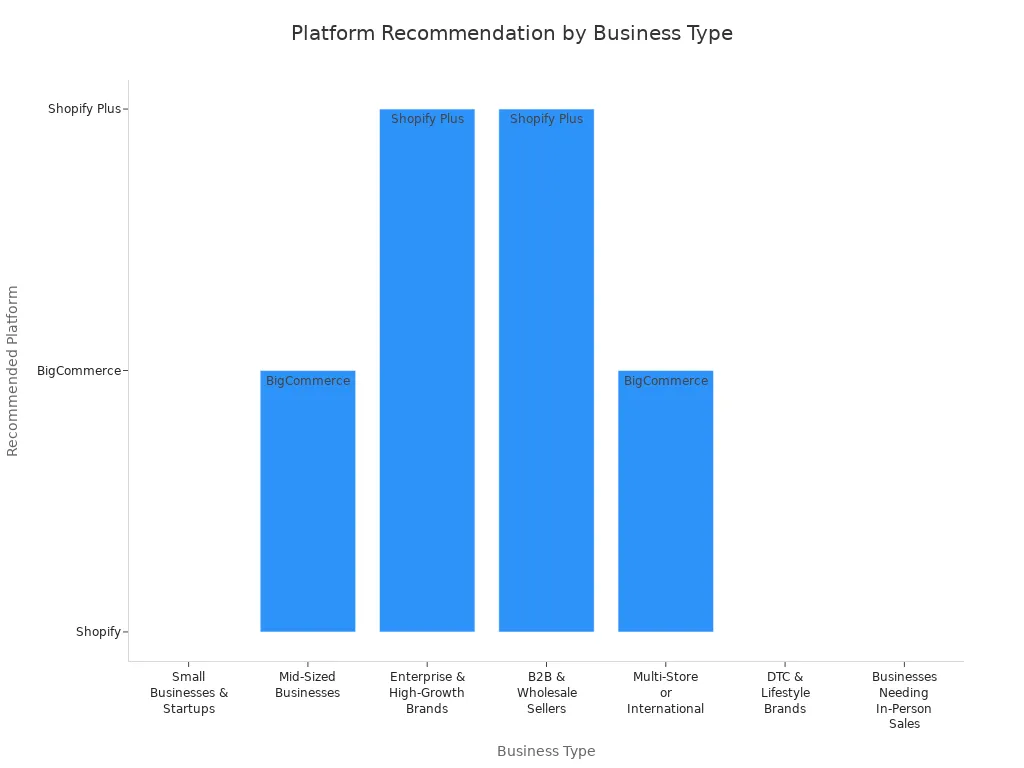
You get a longer free trial with bigcommerce—15 days, no credit card needed. Shopify’s trial is shorter but quick to start. If you want to boost customer engagement, Sobot Live Chat works with both bigcommerce and shopify. You can chat with customers across channels, answer questions fast, and improve satisfaction. Try a free trial on bigcommerce or shopify, or reach out to Sobot for a demo and see how you can grow your business.
FAQ
What is the main difference between BigCommerce vs Shopify?
BigCommerce vs Shopify comes down to flexibility and ease of use. Shopify is easier for beginners. BigCommerce gives you more built-in features. If you want fast setup, Shopify wins. If you need advanced tools, BigCommerce stands out.
Can I use Sobot Live Chat with both Shopify and BigCommerce?
Yes, you can! Sobot Live Chat works with both Shopify and BigCommerce. You can chat with customers on your website, WhatsApp, Facebook, and more. This helps you boost sales and answer questions fast. Learn more at Sobot Live Chat.
Which platform is better for SEO: Shopify vs BigCommerce?
BigCommerce vs Shopify both offer strong SEO tools. BigCommerce gives you more control over URLs and advanced SEO features. Shopify is easier to use but sometimes limits URL changes. Both help your store show up on Google.
How do transaction fees compare in BigCommerce vs Shopify?
Shopify charges extra transaction fees if you do not use Shopify Payments. BigCommerce does not charge extra transaction fees, no matter which payment gateway you pick. This can save you money as your store grows.
Is it easy to switch from Shopify to BigCommerce or vice versa?
You can switch between Shopify and BigCommerce, but you need to move your products, customers, and orders. Many users use apps or services to help with the move. Sobot’s unified workspace keeps your customer chats in one place during the switch.
Tip: Always back up your data before switching platforms. This keeps your store safe and your customers happy.
See Also
Best Ten Live Chat Solutions Compared With Shopify
Authentic Customer Experiences Using Shopify Live Chat
Explore Twelve Live Chat Applications To Boost Shopify
